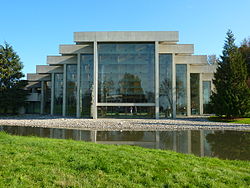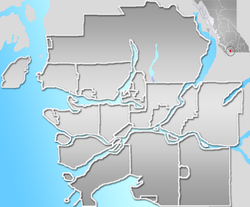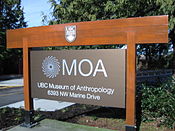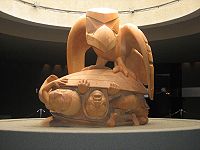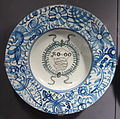- Museum of Anthropology at UBC
-
Coordinates: 49°16′10″N 123°15′35″W / 49.269366°N 123.259596°W
Museum of Anthropology Established 1947 Location 6393 NW Marine Drive, Vancouver, British Columbia, Canada Type First Nations culture Director Anthony Shelton Website Museum of Anthropology The Museum of Anthropology at the University of British Columbia (UBC) campus in Vancouver, British Columbia, Canada is renowned for its displays of world arts and cultures, in particular works by First Nations peoples of the Pacific Northwest Coast First Nations .[1] As well as being a major tourist destination, MOA is also a teaching museum, used in a number of courses at UBC, and a research museum. The MOA holds 36,000 ethnographic objects, as well as 535,000 archaeological objects in its building alone.[2]
Contents
Location
The Museum is located at 6393 Northwest Marine Drive, on the campus of the University of British Columbia. The Museum and UBC lie within the University Endowment Lands, which are not officially part of the City of Vancouver.
History
The museum was founded in 1947 when the items in UBC's ethnographic collection were put on display in the basement of the Main Library. Dr. Harry Hawthorn served as the first director of the new museum, with his wife, Dr. Audrey Hawthorn, serving as its first curator.
In 1971, the museum received funds from the Government of Canada and UBC to begin construction of a new building. In 1976, the new building, designed by renowned Canadian architect Arthur Erickson, opened under new director Michael Ames, who served from 1974 to 1997. Walter and Marianne Koerner's 1975 donation of their extensive collection of Northwest Coast First Nations art to the museum formed a large part of the new building's contents.
In 1997, Dr. Ruth Phillips became museum director. In 2002, Dr. Michael Ames returned as acting director. Dr. Anthony Shelton became director in 2004.
On January 23, 2010, MOA celebrated the completion of its multi-year, multi-million dollar renovation and expansion project, "A Partnership of Peoples".
The new facilities have been developed by UBC Properties Trust and designed by Arthur Erickson and Stantec Architecture. The project comprises several complementary components:
- A new wing, the MOA Centre for Cultural Research, with state-of-the-art collections storage, research rooms, archaeology labs, a community research suite, open plan offices, and Library and Information Centre
- The Multiversity Galleries, housing more than 10,000 objects from around the world
- The 5,800 sq ft (540 m2) Audain Gallery for temporary exhibitions
- A new Café MOA and expanded shop
- The MOACAT digital catalogue system, making collections information (images, audio, and video) available throughout the galleries at the touch of a screen
- The RRN (Reciprocal Research Network), created in partnership with the Musqueam Indian Band, Stó:lō Nation, Stó:lō Tribal Council, and U'mista Cultural Society.[3]
The Museum is affiliated with CHIN, CMA, and Virtual Museum of Canada.
The building
Arthur Erickson's building was inspired by the post-and-beam architecture of northern Northwest Coast First Nations people. Like much of Erickson's work, the building is made primarily out of concrete. In September 2010, a reflecting pool was added to the front of the Museum, funded by Yosef Wosk, OBC. Arthur Erickson and landscape architect Cornelia Oberlander originally intended the pool to be opened as part of the new Museum of Anthropology in 1976; now, nearly thirty-five years later, their original vision for MOA has been fulfilled. Pools had been installed temporarily only three times in MOA’s history: for a movie shoot in 1993, for the APEC leaders’ summit in 1997, and to celebrate Arthur Erickson’s 80th birthday in June 2004.[4]
Highlights
The most iconic object in the Museum is probably the yellow cedar sculpture The Raven and the First Men by Bill Reid, which is depicted on the Canadian twenty-dollar bill.
Other notable Bill Reid works include his Bear and Wasco (Sea Wolf) sculptures, some of his gold jewellery, and a prototype of the Haida dugout canoe he carved for Expo 86.
The Museum contains several large Musqueam artifacts from the late nineteenth and early twentieth centuries, as well as many contemporary works commissioned from Musqueam artists such as Susan Point, Joe Becker, and Robyn and Debra Sparrow.
The Museum's Great Hall contains many fragments of totem poles from Haida and other First Nations villages along British Columbia's coast.
The Museum has an extensive collection from the South Pacific.
There are about 6000 textiles in the collection; about half of these come from Asia. Of particular note are the Cantonese Opera costumes that are considered some of the world's finest. There are excellent holdings from the Northwest Coast, Oceania, Africa, and South America.
The MOA Archive contains approximately 90,000 photographs that cover a wide range of cultures, ethnographic subjects and historical events. The collection dates from the 1890s and is an important resource for researchers, writers and communities.
There are approximately 2800 objects in the African collection. The earlier collections came to MOA via missionaries, travelers, and ex-colonial officers. The collection includes masks, Yoruba thorn carvings, over 100 Makonde figures from Tanzania, approximately 100 Asante gold weights, weaponry from South Africa and about 100 mortuary objects from Egypt.
About 40% of MOA's collection is from Asia. The Chinese collections include between 1000 and 1500 pieces of Chinese ceramics, Chinese calligraphy, and paintings (with four recently identified masterpieces from the collection of Ho Ping-ti). In addition, there is a large collection of Japanese prints, Buddhist art, Hindu art (including Gandhara sculpture), textiles and clothing, and Indian calendar prints. Other collections include 2300 Chinese coins and amulets, 200 Sichuan blue thread embroideries dating to circa 1900, rare Tibetan robes, and masks from Noe (Japan), Sunni and Kolam (Sri Lanka), and Pongsan and Yangju (Korea).
The Haida houses outside the Museum were built under the direction of Bill Reid, who carved, along with Douglas Cranmer, many of the totem poles surrounding them. The original Reid/Cranmer totem pole mounted on the front of the big house was taken inside in 2000 due to deterioration and replaced with the new "Respect to Bill Reid Pole" by Haida artist Jim Hart.
The renewal project
In 2006, the Museum launched a multi-million dollar project to create new research wing, as well as new offices, laboratories, a culturally sensitive research room, recording studio, and a new, 5,800-square-foot (540 m2) exhibition hall, The Audain Gallery. Other enhancements included MOA's new Multiversity Galleries, the creation of the RRN (Reciprocal Research Network) linking Northwest Coast collections around the world, a relocated and expanded Museum Shop, year-round cafe, and courtyard and outdoor 'events pad' suitable for facility rentals. The project was completed in January 2010.
Budgeted at $55.5 million, the Renewal Project received $34.4 million in funding from the Canada Foundation for Innovation and British Columbia Knowledge Development Fund ($17.2 million each), plus from The University of British Columbia, UBC Faculty of Arts, and the Museum itself. Recently, MOA received a major gift of $5.5 million from the Koerner Foundation, Toronto, towards the Project. Approximately $5 million remains to be funded through public sector donations to ensure the project's overall success.
The collections
-
First Nations totem poles and Haida houses
This Museum includes a number of large sculptures, totem poles, and cultural artifacts. Although the museum's focus is on the First Nations of the Northwest Coast, the collection of 36,000 ethnological objects includes objects from all continents. These are mostly located in the Multiversity Galleries, where objects that would normally be stored behind the scenes are made accessible to the public. The collections include contemporary works as well as historical objects. In addition to the ethnographic collections, MOA houses an archaeological collection of approximately 535,000 pieces. These are managed by UBC's Laboratory of Archaeology. The Museum also has a small wing dedicated primarily to European ceramic art works collected by the late Walter Koerner. The Koerner Ceramics Gallery, which opened in 1990, contains over 600 European ceramics collected by Koerner, which he donated to the Museum in 1987.
References
External links
Further reading
- Mayer, Carol Elizabeth; Anthony Shelton (2009), The Museum of Anthropology at the University of British Columbia, University of Washington Press, ISBN 9781553654155, http://books.google.ca/books?id=T-UcJJhUYx4C&lpg=PP1&dq=British%20Columbia&pg=PP1#v=onepage&q&f=true
University of British Columbia Campuses Academics Student life Greek system
and societiesSocialProfessionalAffiliated British Columbia's Children's Hospital · Carey Theological College · Corpus Christi College (Vancouver) · Fisheries Centre · UBC Farm · Kelowna General Hospital · Museum of Anthropology · Regent College · Royal Columbian Hospital · Surrey Memorial Hospital · UBC Press · TRIUMF · GNWC · Vancouver General Hospital · Vancouver Hospital and Health Sciences CentrePeople  History of Canada
History of CanadaTimeline - 18000 BCE–1500 CE
- 1534–1763
- 1763–1866
- 1867–1914
- 1914–1945
- 1945–1960
- 1960–1981
- 1982–1992
- 1992–present
Topics - Constitutional
- Crown & Aboriginals
- Cultural
- Economic
- Events of significance
- Former colonies & territories
- Historic Sites
Immigration - Military - (Conflicts)
- Monarchical
- People of Canada - (Persons of significance)
- Population by year
- Territorial evolution
Provinces &
territoriesCities - Brampton
- Charlottetown
- Fredericton
- Halifax RM
- Hamilton
- Lethbridge
- Moncton
- Montreal
- Northwest Territories capital cities
- Ottawa
- Quebec City
- Regina
- Saskatoon
- Toronto
- Vancouver
- Winnipeg
Categories:- Anthropology museums
- University museums in Canada
- Museums in Vancouver
- First Nations museums in Canada
- Buildings and structures in Greater Vancouver
- University Endowment Lands, British Columbia
- University of British Columbia
- Arthur Erickson buildings
- Modernist architecture in Canada
Wikimedia Foundation. 2010.

